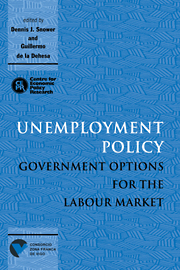Book contents
- Frontmatter
- Contents
- List of figures
- List of tables
- Preface
- Acknowledgements
- List of conference participants
- 1 Introduction
- PART ONE GENERAL POLICY ISSUES
- PART TWO DEMAND MANAGEMENT AND SUPPLY-SIDE POLICY
- PART THREE SUBSIDISING EMPLOYMENT AND TRAINING
- PART FOUR LABOUR MARKET REGULATIONS
- PART FIVE POLICY, JOB REALLOCATION AND THE UNEMPLOYMENT–PRODUCTIVITY RELATION
- PART SIX COMPARING UNEMPLOYMENT POLICIES
- Index
Preface
Published online by Cambridge University Press: 07 September 2010
- Frontmatter
- Contents
- List of figures
- List of tables
- Preface
- Acknowledgements
- List of conference participants
- 1 Introduction
- PART ONE GENERAL POLICY ISSUES
- PART TWO DEMAND MANAGEMENT AND SUPPLY-SIDE POLICY
- PART THREE SUBSIDISING EMPLOYMENT AND TRAINING
- PART FOUR LABOUR MARKET REGULATIONS
- PART FIVE POLICY, JOB REALLOCATION AND THE UNEMPLOYMENT–PRODUCTIVITY RELATION
- PART SIX COMPARING UNEMPLOYMENT POLICIES
- Index
Summary
When it comes to unemployment, economists and policy makers have lost their innocence. There was a time when broad agreement prevailed on what caused unemployment, and what governments should do about it. Since then we have awoken from this comforting dream and have come to recognise that unemployment can have a wide variety of potential causes, matched by a similar variety of policy responses. The trouble is that, in practice, the causes are difficult to identify and the policies difficult to evaluate. This bewildering state of affairs provides the rationale for this book, made possible by the generous financial support of Consorcio de la Zona Franca de Vigo. Its aim is to provide an overview of the available unemployment policies, a rigorous analysis of how they work, and an assessment of their robustness in the face of unemployment's multiple causes.
Before embarking on this undertaking, it is important to be aware from where we have come. The world used to be so simple. In the first two decades of the postwar period, economists were agreed that governments could spend their way out of unemployment. Their diagnosis was straightforward and so was their policy prescription: unemployment was due to an insufficient demand for labour, and firms were not demanding enough labour because there was an insufficient demand for their products. So, if the private sector of the economy was not spending enough, then the government could reduce unemployment by spending more itself.
- Type
- Chapter
- Information
- Unemployment PolicyGovernment Options for the Labour Market, pp. xxi - xxiiiPublisher: Cambridge University PressPrint publication year: 1997



